 And as our calendars flip over to February, it’s clear that the date itself, January 13, wasn’t particularly remarkable for me. But knowing the anniversary was passing caused me to look back and reflect. And as I did, I was reminded of how simply it began, as a desire to display photographs and art and write about nature. And I see what it has now become, an interactive community of mutual sharing, learning, mentoring and inspiration.
And as our calendars flip over to February, it’s clear that the date itself, January 13, wasn’t particularly remarkable for me. But knowing the anniversary was passing caused me to look back and reflect. And as I did, I was reminded of how simply it began, as a desire to display photographs and art and write about nature. And I see what it has now become, an interactive community of mutual sharing, learning, mentoring and inspiration.And so to celebrate my first year, I want to highlight for you, in this post and the next, two aspects of blogging that have become particularly important to me and inseparable--the stage and the inspiration it provides.
 The stage of course is the blogging platform, a place to "perform", to publish your writing, your photographs, your artistic endeavors, whatever they may be, to an audience that remains largely anonymous but that can span the globe. It makes the sage advice, “You make your stage. The audience is waiting”, spring vividly to life.
The stage of course is the blogging platform, a place to "perform", to publish your writing, your photographs, your artistic endeavors, whatever they may be, to an audience that remains largely anonymous but that can span the globe. It makes the sage advice, “You make your stage. The audience is waiting”, spring vividly to life. Every stage we create has something to give us. We step forward, find our courage. We practice and make our mistakes. We change and we get stronger, not just on the blogging stage, but in every aspect of our lives. We learn as we create and we learn as we experience the stage, whether it's this stage or any other we have selected.
Every stage we create has something to give us. We step forward, find our courage. We practice and make our mistakes. We change and we get stronger, not just on the blogging stage, but in every aspect of our lives. We learn as we create and we learn as we experience the stage, whether it's this stage or any other we have selected. I was recently talking with a friend who is a published author and artist, and said, “I haven’t done one thing toward publishing my novel. It just sits there along with the writer’s market books that are stacked on my buffet and I do nothing.”
I was recently talking with a friend who is a published author and artist, and said, “I haven’t done one thing toward publishing my novel. It just sits there along with the writer’s market books that are stacked on my buffet and I do nothing.”“Well, why not? Why aren't you getting it out there?” he asked.
“Umm…avoidance, I think. I’m shy.”
“You’re shy? What do you mean you’re shy? I’ve never seen that in you.” We stared at each other. I finally spoke.
“I don’t look shy. It’s what we sometimes call counter-phobic in the mental health field. Everything I love requires that I be on stage. So I push myself out there until I make it look easy, but it’s really not.”
 And that is one of the many ways this stage has become important to me—practice. We create, we let the world see what we have to say and then we’re stimulated to create again by the very stage we dance on. It’s an energy that feeds itself. We get some feedback and we have some control. But most of all, the more we practice the more courage we have to say what it is we have to say and to show the world who we are through our passions and creations.
And that is one of the many ways this stage has become important to me—practice. We create, we let the world see what we have to say and then we’re stimulated to create again by the very stage we dance on. It’s an energy that feeds itself. We get some feedback and we have some control. But most of all, the more we practice the more courage we have to say what it is we have to say and to show the world who we are through our passions and creations. Next post: The inspiration in blogging
Next post: The inspiration in bloggingPhotos from top to bottom: Greater sandhill cranes at Bosque del Apache (more in an upcoming post); Golden-crowned kinglet in watercolor (also upcoming); possible female rufous or broad-winged hummingbird in New Mexico; a stack of writer's market books; me (right) with Natalie Goldberg (2008), who doesn't like photos, but isn't shy about her teachings; writing and hiking buddies in the Santa Fe National Forest in New Mexico (2008).

 For those of you who may be unfamiliar with it, the suet nickname refers to infamous blogger, NPR commentator, author, artist, naturalist,
For those of you who may be unfamiliar with it, the suet nickname refers to infamous blogger, NPR commentator, author, artist, naturalist,  I made my first batch less than two weeks ago and just before our Tennessee thermostats plummeted into
I made my first batch less than two weeks ago and just before our Tennessee thermostats plummeted into  A
A
 They were cautious about approaching the feeders, but eagerly snatched the tidbits scattered on the ground. A parade of other suet lovers has followed, among them, the frequent visiting white-breasted
They were cautious about approaching the feeders, but eagerly snatched the tidbits scattered on the ground. A parade of other suet lovers has followed, among them, the frequent visiting white-breasted  The happy chattering of this
The happy chattering of this  A couple of days ago, instead of chatter, I heard him scolding. I looked out to find him perched over an empty plate. Visitors had come in the night and cleaned up all the leftovers leaving behind plenty of scat on the ground.
A couple of days ago, instead of chatter, I heard him scolding. I looked out to find him perched over an empty plate. Visitors had come in the night and cleaned up all the leftovers leaving behind plenty of scat on the ground. Hmmmm. Raccoon? Opossum? It didn’t look like any scat I found on the web. I became more judicious about handing out dough and started bringing the suet plate in at night. Then last night, a sound outside the door. I turned off the inside light and flipped on the porch light to take a peek and look who I found.
Hmmmm. Raccoon? Opossum? It didn’t look like any scat I found on the web. I became more judicious about handing out dough and started bringing the suet plate in at night. Then last night, a sound outside the door. I turned off the inside light and flipped on the porch light to take a peek and look who I found. Kind of cute, huh? But I think ‘pure trouble’ is a better description. His buddy sauntered off when he spotted me in the window.
Kind of cute, huh? But I think ‘pure trouble’ is a better description. His buddy sauntered off when he spotted me in the window. This male American goldfinch was feasting on sunflower seeds at my feeder and showing off brighter colors. The black on his wings and tail was richer and darker and he was sporting some bright yellow mixed in with his winter olive.
This male American goldfinch was feasting on sunflower seeds at my feeder and showing off brighter colors. The black on his wings and tail was richer and darker and he was sporting some bright yellow mixed in with his winter olive.  Cornell lab says the American goldfinch changes from winter plumage to its bright golden breeding plumage through a complete molt of its feathers. It is the only finch in its
Cornell lab says the American goldfinch changes from winter plumage to its bright golden breeding plumage through a complete molt of its feathers. It is the only finch in its  Even when my photos are
Even when my photos are  A goldfinch study. I will be watching for my subject's black cap to arrive right along with spring!
A goldfinch study. I will be watching for my subject's black cap to arrive right along with spring! Soon after it peeks over the horizon, the mountains in the distance take on a bluish hue and a soft fog rises briefly in the valley below. My first visitor to the birdbath is often this
Soon after it peeks over the horizon, the mountains in the distance take on a bluish hue and a soft fog rises briefly in the valley below. My first visitor to the birdbath is often this  He announces his presence with a squawk that is becoming familiar and if the bath is frozen I soon add water. Think maybe he's training me?
He announces his presence with a squawk that is becoming familiar and if the bath is frozen I soon add water. Think maybe he's training me?

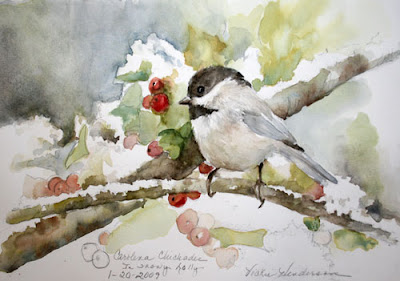 Sketching is fun because its relaxed. Generally used for
Sketching is fun because its relaxed. Generally used for 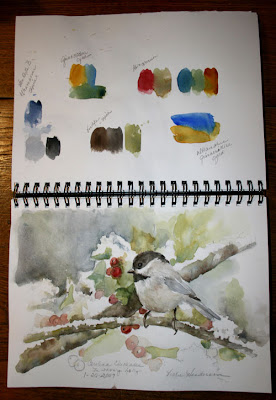 It's a doubly worthwhile experience to take photos as the sketch progresses. I'm discovering this as I remind myself to do it. You get to see what's happening twice, once while you are deep in your creative brain, wandering the uncharted territory of color, shape and perspective as it relates to a ne
It's a doubly worthwhile experience to take photos as the sketch progresses. I'm discovering this as I remind myself to do it. You get to see what's happening twice, once while you are deep in your creative brain, wandering the uncharted territory of color, shape and perspective as it relates to a ne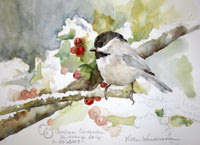
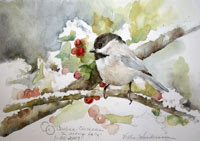
 Generally, I like to begin with the background when I start a painting, to see how the colors and light play out. Then I work with the painting focus to make sure these same colors are reflected in the subject.
Generally, I like to begin with the background when I start a painting, to see how the colors and light play out. Then I work with the painting focus to make sure these same colors are reflected in the subject.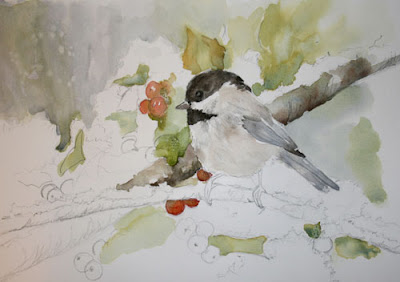

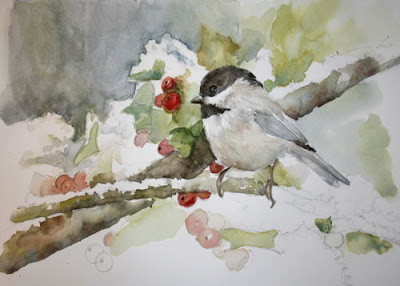 In the end the sketch was wonderful practice. I noticed and corrected details in the placement of the eye, the shape of the beak, the shape of the white feather pattern against the black cap. I also noticed snow. It's crusty and irregular. I lost my snow shapes easily. So, with my sketch to remind me, I'll draw the snow detail more carefully in the final painting.
In the end the sketch was wonderful practice. I noticed and corrected details in the placement of the eye, the shape of the beak, the shape of the white feather pattern against the black cap. I also noticed snow. It's crusty and irregular. I lost my snow shapes easily. So, with my sketch to remind me, I'll draw the snow detail more carefully in the final painting. Inauguration day. New hope and new energy for the world.
Inauguration day. New hope and new energy for the world.
 But we've had no snow to speak of in the
But we've had no snow to speak of in the  I drove to a meeting mid-day and spent a pleasant couple of hours watching snow fall through large paned windows as we held our discussion beside a warm fire.
I drove to a meeting mid-day and spent a pleasant couple of hours watching snow fall through large paned windows as we held our discussion beside a warm fire.  On the drive home, at 36 degrees F, the clouds of falling snow quickly turned to water and it seemed the show was over. But when I turned off to climb the hill where I live, the trees magically transformed into a fairyland of wintery boughs of fluff.
On the drive home, at 36 degrees F, the clouds of falling snow quickly turned to water and it seemed the show was over. But when I turned off to climb the hill where I live, the trees magically transformed into a fairyland of wintery boughs of fluff. The light was gray and snow still falling when I snapped these photos.
The light was gray and snow still falling when I snapped these photos.  And despite being a non-native species, this
And despite being a non-native species, this 
 Sigh.... Maybe one day they'll make glass that won't confuse my automatic focus.
Sigh.... Maybe one day they'll make glass that won't confuse my automatic focus. I can count on the
I can count on the 
 When I looked at these photos I couldn't help but laugh. The birdbath had shifted in the soggy ground making the water farther away on one edge than the other. And when the artic air arrived, the ground froze so I could neither remove the ice nor straighten the bowl.
When I looked at these photos I couldn't help but laugh. The birdbath had shifted in the soggy ground making the water farther away on one edge than the other. And when the artic air arrived, the ground froze so I could neither remove the ice nor straighten the bowl.  The pine siskin that landed on the 'away' side had a time, not only with the distance he had to reach for the water, but the smooth surface on which he perched. You can see a curious, contemplative and even frustrated experience going on in his behavior.
The pine siskin that landed on the 'away' side had a time, not only with the distance he had to reach for the water, but the smooth surface on which he perched. You can see a curious, contemplative and even frustrated experience going on in his behavior.



 Okay, lets try this another way.
Okay, lets try this another way. I first thought that I just hadn't been observant enough in the past. Pine siskins are new to me this season. But a naturalist friend of mine in the area,
I first thought that I just hadn't been observant enough in the past. Pine siskins are new to me this season. But a naturalist friend of mine in the area,  Reading about pine siskins just makes these birds all the more intriguing to me and so I will be observing and reading more as the winter progresses.
Reading about pine siskins just makes these birds all the more intriguing to me and so I will be observing and reading more as the winter progresses.






